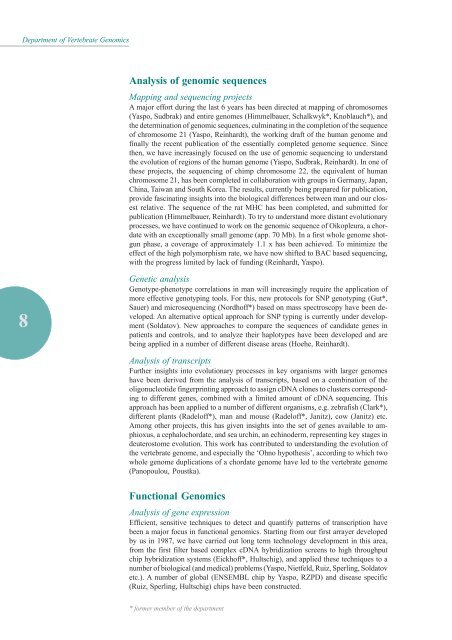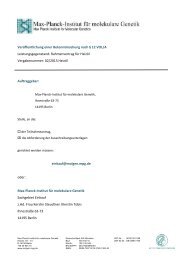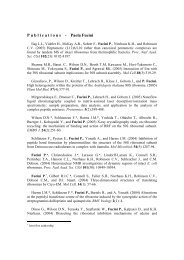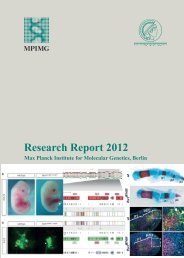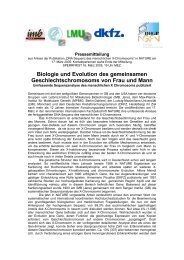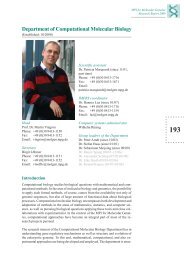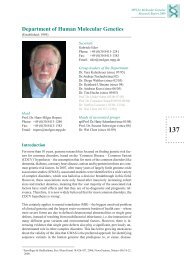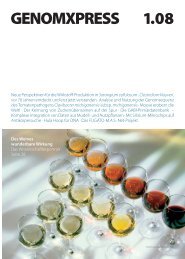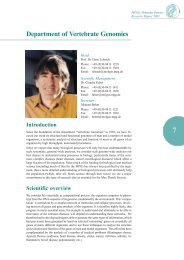Research Report 2003 - Max-Planck-Institut für molekulare Genetik
Research Report 2003 - Max-Planck-Institut für molekulare Genetik
Research Report 2003 - Max-Planck-Institut für molekulare Genetik
Create successful ePaper yourself
Turn your PDF publications into a flip-book with our unique Google optimized e-Paper software.
Department of Vertebrate Genomics<br />
8<br />
Analysis of genomic sequences<br />
Mapping and sequencing projects<br />
A major effort during the last 6 years has been directed at mapping of chromosomes<br />
(Yaspo, Sudbrak) and entire genomes (Himmelbauer, Schalkwyk*, Knoblauch*), and<br />
the determination of genomic sequences, culminating in the completion of the sequence<br />
of chromosome 21 (Yaspo, Reinhardt), the working draft of the human genome and<br />
finally the recent publication of the essentially completed genome sequence. Since<br />
then, we have increasingly focused on the use of genomic sequencing to understand<br />
the evolution of regions of the human genome (Yaspo, Sudbrak, Reinhardt). In one of<br />
these projects, the sequencing of chimp chromosome 22, the equivalent of human<br />
chromosome 21, has been completed in collaboration with groups in Germany, Japan,<br />
China, Taiwan and South Korea. The results, currently being prepared for publication,<br />
provide fascinating insights into the biological differences between man and our closest<br />
relative. The sequence of the rat MHC has been completed, and submitted for<br />
publication (Himmelbauer, Reinhardt). To try to understand more distant evolutionary<br />
processes, we have continued to work on the genomic sequence of Oikopleura, a chordate<br />
with an exceptionally small genome (app. 70 Mb). In a first whole genome shotgun<br />
phase, a coverage of approximately 1.1 x has been achieved. To minimize the<br />
effect of the high polymorphism rate, we have now shifted to BAC based sequencing,<br />
with the progress limited by lack of funding (Reinhardt, Yaspo).<br />
Genetic analysis<br />
Genotype-phenotype correlations in man will increasingly require the application of<br />
more effective genotyping tools. For this, new protocols for SNP genotyping (Gut*,<br />
Sauer) and microsequencing (Nordhoff*) based on mass spectroscopy have been developed.<br />
An alternative optical approach for SNP typing is currently under development<br />
(Soldatov). New approaches to compare the sequences of candidate genes in<br />
patients and controls, and to analyze their haplotypes have been developed and are<br />
being applied in a number of different disease areas (Hoehe, Reinhardt).<br />
Analysis of transcripts<br />
Further insights into evolutionary processes in key organisms with larger genomes<br />
have been derived from the analysis of transcripts, based on a combination of the<br />
oligonucleotide fingerprinting approach to assign cDNA clones to clusters corresponding<br />
to different genes, combined with a limited amount of cDNA sequencing. This<br />
approach has been applied to a number of different organisms, e.g. zebrafish (Clark*),<br />
different plants (Radeloff*), man and mouse (Radeloff*, Janitz), cow (Janitz) etc.<br />
Among other projects, this has given insights into the set of genes available to amphioxus,<br />
a cephalochordate, and sea urchin, an echinoderm, representing key stages in<br />
deuterostome evolution. This work has contributed to understanding the evolution of<br />
the vertebrate genome, and especially the ‘Ohno hypothesis’, according to which two<br />
whole genome duplications of a chordate genome have led to the vertebrate genome<br />
(Panopoulou, Poustka).<br />
Functional Genomics<br />
Analysis of gene expression<br />
Efficient, sensitive techniques to detect and quantify patterns of transcription have<br />
been a major focus in functional genomics. Starting from our first arrayer developed<br />
by us in 1987, we have carried out long term technology development in this area,<br />
from the first filter based complex cDNA hybridization screens to high throughput<br />
chip hybridization systems (Eickhoff*, Hultschig), and applied these techniques to a<br />
number of biological (and medical) problems (Yaspo, Nietfeld, Ruiz, Sperling, Soldatov<br />
etc.). A number of global (ENSEMBL chip by Yaspo, RZPD) and disease specific<br />
(Ruiz, Sperling, Hultschig) chips have been constructed.<br />
* former member of the department


